
| KIT #: | ZV7202 |
| PRICE: | $18.95 MSRP |
| DECALS: | Two options |
| REVIEWER: | Kevin Thompson |
| NOTES: | Third in a series on Vietnam MiGs |

| HISTORY |
May 10, 1972 was perhaps one of the busiest days in the history of the air war over North Viet Nam. It was on this day that the United States Air Force and Navy began Operation Linebacker I, with stepped-up bombing of North Vietnamese airfields and other military installations. Heavy attacks were carried out by B-52s based out of Thailand, with USAF and Navy F-4 Phantom II fighter-bombers in the support role. It was on this day that Randy Cunningham and Willy Driscoll shot down three MiG-17s, and became the only US Navy aces of the Viet Nam war.
By mid-1972, the Vietnamese People’s
Air Force (VPAF) had created a second MiG-21-equipped Fighter Regiment. In
addition to the 921st “Sao Do” (Red Star) Fighter Regiment, the new
927th “Lam Son” (Blue River) Fighter Regiment was now on strength
with 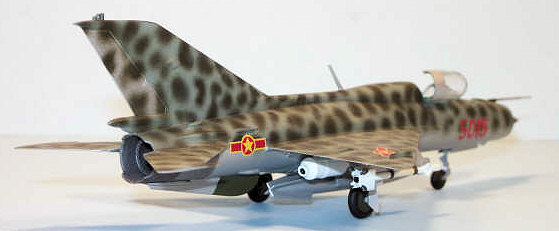 the MiG-21PFM. The MiG-21PFM (NATO code-name Fishbed-F) was the
third main variant of the type in use by the VPAF, and was the last of the
second-generation MiG-21 series. The VPAF received the PFM variant in late-1967,
and eventually had over 100 of the type, though not all at once due to
attrition. Designed as a multi-purpose follow-on to the MiG-21PF, the PFM had an
upgraded engine and electronics, featured a broad-chord fin and vertical
stabilizer as on the late PF series, and a two-piece canopy that was hinged to
the right side while the windscreen remained stationary. The PFM also had the
ability to utilize the SPRD-99 booster rockets to dramatically shorten the
take-off roll distance. This was particularly important during Linebacker I
operations, when some of the runways at VPAF airfields were damaged from U.S.
bombing attacks, frequently necessitating take-off from the base taxiways!
the MiG-21PFM. The MiG-21PFM (NATO code-name Fishbed-F) was the
third main variant of the type in use by the VPAF, and was the last of the
second-generation MiG-21 series. The VPAF received the PFM variant in late-1967,
and eventually had over 100 of the type, though not all at once due to
attrition. Designed as a multi-purpose follow-on to the MiG-21PF, the PFM had an
upgraded engine and electronics, featured a broad-chord fin and vertical
stabilizer as on the late PF series, and a two-piece canopy that was hinged to
the right side while the windscreen remained stationary. The PFM also had the
ability to utilize the SPRD-99 booster rockets to dramatically shorten the
take-off roll distance. This was particularly important during Linebacker I
operations, when some of the runways at VPAF airfields were damaged from U.S.
bombing attacks, frequently necessitating take-off from the base taxiways!
VPAF records, as listed in MiG-21 Units of The Vietnam War by Istvan Toperczer, Osprey Combat Aircraft No. 29, show four claimed kills for May 10, 1972, all F-4 Phantoms. 927th pilot Le Thanh Dao shot down a Navy F-4J of VF-92 from the USS Constellation on this day. May 10, 1972 witnessed some of the fiercest fighting of the entire air war. The US Navy and USAF claimed a combined four MiG-21s and seven MiG-17s on that day, and admitted to losing only two Phantoms to VPAF fighters. The VPAF claimed two F-4s downed by MiG-19s of the 925th Fighter Regiment, two by 921st MiG-21s and a further two by 927th Fishbeds. The MiG-21PFM was the most numerous Fishbed variant in the VPAF inventory, and was later joined by the third-generation MiG-21MF Fishbed-J.
| THE KIT |
Before going into detail on this
Russian-made kit, it will be necessary to detract one or more statements I made
in my previous review of the Fujimi MiG-21PF kit. Apparently, I had not done
enough research before “jumping the gun” and crowning the Fujimi kit king of all
1/72 MiG-21 kits. A closer look at more recent MiG-21 releases (including this
one from Zvezda, a couple from Bilek, and the recent Revell Germany MiG-21F-13),
reveal some serious inaccuracies in the Fujimi kit. The majority of these
inaccuracies are in the forward fuselage, canopy and landing gear, where a few
of the dimensions are too thick, tall or out of scale.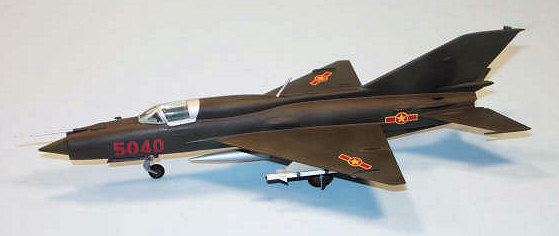 The MiG-21 is a very small airplane when compared to many western designs, and
its size and dimensions become apparent when comparing various kits of the same
scale.
The MiG-21 is a very small airplane when compared to many western designs, and
its size and dimensions become apparent when comparing various kits of the same
scale.
This is the first Zvezda kit I have built. In fact, I have not even seen any of their other offerings yet. This is the only kit of the PFM variant so far, and as I was doing a series of VPAF MiGs in this scale, the PFM was a must since it was so widely used. This is a good kit. It features crisp molding in medium gray with recessed panel lines. The overall outline and dimensions of the fuselage and tail feathers far surpass the Fujimi PF kit. For many years, Eastern-Bloc kits (including KP) couldn’t hold a candle to western products for overall accuracy, thickness and fit. Well that has all changed now. This Zvezda kit is the product of some thoroughly researched engineering and attention to detail. There is a total of 92 pieces, including rocket pods, SPRD-99 rocket boosters, RS-3 “Atoll” missiles, an eight-piece cockpit with reasonable detail in this scale, and a two-piece canopy and windscreen that can be completed in either the opened or closed position. Keep in mind that this kit’s price is about ten bucks under that of the Fujimi offerings. The decal sheet features markings for both Soviet and Vietnamese aircraft, although the national insignia for the latter version appear to be a bit large and out of proportion. Aftermarket decals will be used. Because of the variety of VPAF paint schemes for the PFM, I actually purchased four of these kits for my collection, but at the time of assembly, I did (only) two of them simultaneously. So let’s get started with this kit.
| CONSTRUCTION |
First thing was the cockpit
consisting of eight pieces, including tub, seat, stick, base, instrument panel,
gun sight and two side consoles. The majority was painted with the Testors
“Russian Interior Blue”, with the seat in neutral gray, and details highlighted
with black and silver. A good reference is MiG-21 Walk Around
by Hans-Heiri Stapfer, Squadron Signal Publications. This book has lots of
color photos of first and second-generation MiG-21 cockpits, undercarriages and
other details and is a must for MiG-21 modelers. The side consoles are cemented
to the insides of the fuselage halves, as are the main gear bays, front gear
bay, and 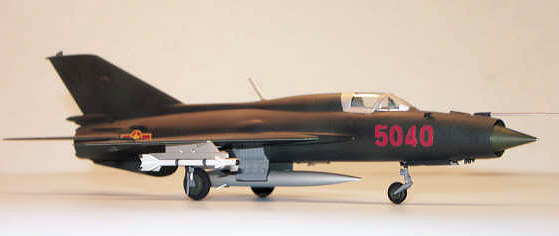 exhaust afterburner assembly, which was painted with Testors Jet
Exhaust Metalizer. Before joining the fuselage halves, approximately ½ ounce of
lead weight was fitted into the inside fuselage ahead of the cockpit to ensure
proper sitting on its nosewheel. Once the fuselage was joined together, wings
and tail feathers were added, as well as the intake ring in the nose. This is
where I found the only real flaw of this kit. The nose cone is too wide at its
base, and as a result would have been too long once cemented in place. So before
it was glued in, I sanded off about 1/16th of an inch from its base,
and re-fitted it. This dimension equals out to only about 5 inches on the full
size aircraft, but once the cone is shortened, its length and diameter
relationship to the intake ring match up properly.
exhaust afterburner assembly, which was painted with Testors Jet
Exhaust Metalizer. Before joining the fuselage halves, approximately ½ ounce of
lead weight was fitted into the inside fuselage ahead of the cockpit to ensure
proper sitting on its nosewheel. Once the fuselage was joined together, wings
and tail feathers were added, as well as the intake ring in the nose. This is
where I found the only real flaw of this kit. The nose cone is too wide at its
base, and as a result would have been too long once cemented in place. So before
it was glued in, I sanded off about 1/16th of an inch from its base,
and re-fitted it. This dimension equals out to only about 5 inches on the full
size aircraft, but once the cone is shortened, its length and diameter
relationship to the intake ring match up properly.
Once I had a basic airframe completed, it was time to sand the seams. Fit on this kit is very good, seams are minimal and no filler was required. After I had completed the sanding through 400 wet, it was time to add all the other “fiddly bits” that would have proved too fragile, such as the main and nose gear doors, afterburner cooling ducts, air data probes, air brakes (all in the closed position), and missile pylons. Once these pieces were all properly aligned and thoroughly dry, it was time for the paint shop.
| COLORS & MARKINGS |
As I have previously mentioned,
Istvan Toperczer’s two books on the VPAF are probably the best reference
materials available on the subject. They are in the Osprey Combat Aircraft
series, and are number 25 for the MiG-17 and MiG-19 Units of The Vietnam War,
and number 29 for the MiG-21 volume. Both books have excellent color side view
artwork, and the MiG-21 book features eighteen
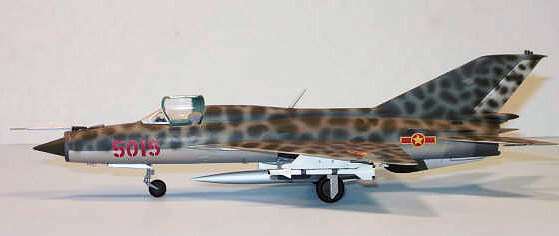 such renderings. While nearly all VPAF MiG-21s were in bare metal when received, intensified US bombing activity
from 1968-on necessitated the camouflaging of a select few aircraft to blend in
with the foliage of the area. The painting of these aircraft was done in a hasty
manner with very little consistency. After reviewing all of my options, I
selected two schemes which I found to be the most interesting and attractive.
The first scheme is bort number 5015, an aircraft from the 921st
Fighter Regiment based at Noi Bai airfield from 1968. It is in medium green with
dark green splotches on the upper surfaces, and natural metal undersides. In
addition to the color side view artwork, there are at least two decent
black-and-white photos in the book to “back up” the artwork. This is an unusual
scheme and was only applied to perhaps one or two other aircraft, including bort
number 5017.
such renderings. While nearly all VPAF MiG-21s were in bare metal when received, intensified US bombing activity
from 1968-on necessitated the camouflaging of a select few aircraft to blend in
with the foliage of the area. The painting of these aircraft was done in a hasty
manner with very little consistency. After reviewing all of my options, I
selected two schemes which I found to be the most interesting and attractive.
The first scheme is bort number 5015, an aircraft from the 921st
Fighter Regiment based at Noi Bai airfield from 1968. It is in medium green with
dark green splotches on the upper surfaces, and natural metal undersides. In
addition to the color side view artwork, there are at least two decent
black-and-white photos in the book to “back up” the artwork. This is an unusual
scheme and was only applied to perhaps one or two other aircraft, including bort
number 5017.
The second scheme chosen was that of
Le Thanh Dao’s aircraft, bort number 5040 of the 927th Fighter
Regiment. It was in this aircraft that he shot down a Navy F-4J of VF-92 on the
May 10, 1972 mission. Also an interesting scheme, this aircraft is in overall
dark green with an even slightly darker green random pattern on the upper
surfaces. Now I am at the mercy of the artwork here, for I do not have any
photographic evidence of this aircraft that clearly shows the underside. It is
possible that the entire aircraft
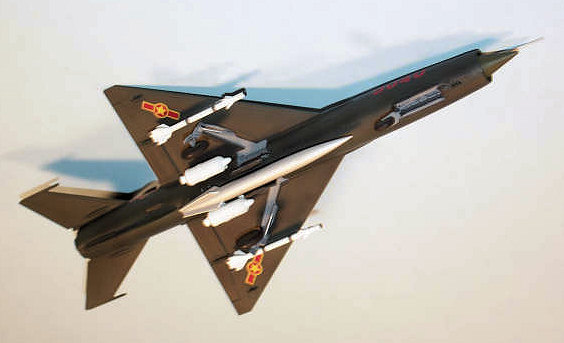 surface was painted in this green, with the
exception of the missile pylons, VHF antenna and canopy framing. In fact, both
aircraft have un-painted, natural metal canopy framing and antennae.
surface was painted in this green, with the
exception of the missile pylons, VHF antenna and canopy framing. In fact, both
aircraft have un-painted, natural metal canopy framing and antennae.
Colors chosen for the first aircraft was Model Master 1716 Pale Green FS 34227 mixed with some 1728 Light ghost Gray FS 36375 for the main upper surface, with the spots in 1710 Dark Green FS 34079 slightly darkened with flat black. Undersurface is Model Master Aluminum Non-Buffing Metalizer. These MiGs were subject to rough use in a harsh climate. None of them were polished or pretty. The second aircraft was done in overall FS 34079 with the darker green the same 34079 darkened with a touch of black. As previously mentioned, this scheme on 5040 is speculative at best. I will never know for sure because in May 1972 I was 10 years old, and living in Laguna Niguel, California, maybe 8000 miles from Viet Nam!
The nose cone, and dielectric panels on the vertical fins are another green altogether, and I used Model Master 1713 Medium Green FS 34102 for these as well as the wheel hubs. Once the paint jobs were dry, both kits were gloss coated for decal preparation. My own “home grown” VPAF insignia and bort number decals were used (printed expertly by Mark Borer, a first officer with a major airline and part-time modeler). The VPAF “star and bar” are in six positions, and the bort numbers are on the forward fuselage on both sides. VPAF aircraft had very simple markings. After decals were set, a couple coats of dull coat were applied.
| FINAL CONSTRUCTION |
 Missiles were painted in flat
white with dark metallic bands and fin tips, and gloss black nose tips.
Centerline tanks were natural metal on both aircraft, as were the canopy and
windshield framing. Gear bays inside are Model Master 1725 Neutral Gray FS
36270, as well as the gear legs and inside gear doors. The SPRD-99 rocket
boosters were painted flat white and attached to the lower fuselage. Landing
gear was installed, as well as centerline tanks, main pitot tube, missiles and
canopy. Just to be different, one aircraft has an opened canopy and the other
one closed. Once all pieces had been fitted, the finishing touch is that single
drop of chrome silver at the tip of the intake spike. And there are two
completed VPAF MiG-21PFMs.
Missiles were painted in flat
white with dark metallic bands and fin tips, and gloss black nose tips.
Centerline tanks were natural metal on both aircraft, as were the canopy and
windshield framing. Gear bays inside are Model Master 1725 Neutral Gray FS
36270, as well as the gear legs and inside gear doors. The SPRD-99 rocket
boosters were painted flat white and attached to the lower fuselage. Landing
gear was installed, as well as centerline tanks, main pitot tube, missiles and
canopy. Just to be different, one aircraft has an opened canopy and the other
one closed. Once all pieces had been fitted, the finishing touch is that single
drop of chrome silver at the tip of the intake spike. And there are two
completed VPAF MiG-21PFMs.
| CONCLUSIONS |
 The MiG-21 is much like the P-51
Mustang (or any other really famous warbird) in that it was built in huge
quantities, saw extensive combat, and is famous all over the world. It has also
been kitted extensively over the years, often times inaccurately. As the years
have gone by, especially since the 1970s, MiG-21 kits have gotten better and
better, and much more numerous. These recent kits from Zvezda are proof that
eastern kits can now rival their western counterparts for outright quality. With
the exception of the nose cone length issue (a very simple fix), I cannot find
fault with this kit. It is well molded, has accurate outline and thicknesses,
reasonable detail, and a good fit. The price in the $15.00 region is very
competitive, and the kit is well worth it. These little MiGs have been a very
rewarding build.
The MiG-21 is much like the P-51
Mustang (or any other really famous warbird) in that it was built in huge
quantities, saw extensive combat, and is famous all over the world. It has also
been kitted extensively over the years, often times inaccurately. As the years
have gone by, especially since the 1970s, MiG-21 kits have gotten better and
better, and much more numerous. These recent kits from Zvezda are proof that
eastern kits can now rival their western counterparts for outright quality. With
the exception of the nose cone length issue (a very simple fix), I cannot find
fault with this kit. It is well molded, has accurate outline and thicknesses,
reasonable detail, and a good fit. The price in the $15.00 region is very
competitive, and the kit is well worth it. These little MiGs have been a very
rewarding build.
| REFERENCES |
Mig-21 Units of The Vietnam War by Istvan Toperczer, Osprey Combat Aircraft number 29, 2001 Osprey Publishing Limited.
MiG-21 Fishbed Walk Around Part 1 by Hans-Heiri Stapfer. 2004 Squadron Signal Publications.
January 2007
Copyright ModelingMadness.com. All rights reserved. No reproduction in part or in whole without express permission from the editor.
If you would like your product reviewed fairly and fairly quickly, please contact the editor or see other details in the Note to Contributors.
Back to the Review Index Page 2024